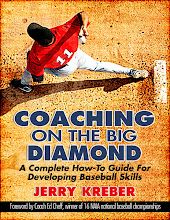Wednesday, November 08, 2006
Catcher: The Most Underpracticed Position


Catching: Baseball's Lost Art
In a three man coaching staff, catchers are often forgotten about as the attention focuses on infield, outfield, and pitching performances. Catchers are left in the dark, catching bullpens and flipping balls to their coach during groundball sessions. This year, one of our coaching goals was to improve the play of our catchers. By doing this, we wanted to be able to play two catchers on a regular rotation. With this method, one catcher would always be fresh and ready to go. That way, each catcher could play another position, thus becoming more versatile and less one dimensional. To be fair, our pitchers had to be comfortable throwing to each backstop. Also, each catcher had to have the ability to control the opponents running game as well as be a field general. To help enhance our catchers performance we operated a drill progression that help improve lower body durability, side to side movement, and stance explosion.
Point Drill: A few years ago, I saw LSU run this drill during a CWS workout. Our catchers start in a regular crouched stance. A coach, standing out front, points a direction. The catcher reaches out and frames an imaginary pitch. With the glove arm extended, the catcher waits for the coach to point a different direction. The coach can point left, right, up, or down and the catcher will proceed to frame different pitch locations. The catcher should remember to causally move their upper body to the center of each pitch, making the ball look as good as possible. Coaches should start out conservative with the time for this drill, but gradually extend each period. This is an excellent drill to promote strength and durability to the lower body.
Half Circle Drill: Catchers start in a regular crouched stance behind home plate. The coach should draw a half circle in the dirt, right in front of the catcher. The half circle should look like it is swallowing the plate. Standing in front of home plate, coaches should short hop balls for the catchers to block. The catcher should try and move their torso so the blocked ball drops in the half circle drawn by the coach. Players must be able to move laterally, keeping the ball in front of them.
Four Corner Drill: With four cones evenly spaced forming a square, a catchers will crouch behind them. Each cone will act as a home plate. With a coach's signal, the catcher will explode out of stance. Catchers should use a jump turn, using quick feet rotating the shoulders powerfully toward second base. After footwork completion, catchers will rotate to the next cone. Coaches can use this drill to condition catchers and prepare them for the season's long duration.
Two Knee Throwing: Catchers start in a regular crouched stance behind home plate, with a player standing on the mound. If the entire infield is available, a player could stance at second base. A coach standing 5-10 in front of home plate, throws balls to the catcher. Upon reception, catchers should drop to two knees and fire toward second base. The drill works faster if the throw goes to the mound, but throwing all the way through really challenges the catcher to gain momentum during extension toward the ball. If the catcher is just throwing to a mound target, the still need to put second base force on the ball. Coaches can really evalute arm strength when performing this drill. Also, players can improve arm strength by this drill's arm isolation.
Catch and Release: Catchers start in a regular crouched stance behind home plate, with a player standing on the mound. If the entire infield is available, a player could stance at second base. Coaches, standing in front of the plate, will throw balls to the catcher. Upon reception, catchers will step and throw toward second base. Quickness in the glove transfer should be the main focus of this drill. Catchers should not concentrate on anything but catching and throwing as fast as possible. If the catcher is just throwing to a mound target, the still need to put second base force on the ball.
Jump Turn and Throw: Catchers start in a regular crouched stance behind home plate, with a player standing on the mound. If the entire infield is available, a player could stance at second base. Coaches, standing in front of the plate, will throw balls to the catcher. Upon reception, catchers will concentrate on turning glove shoulder toward second base and throwing in a straight line. Turning and pivoting the body as fast as possible should be the catchers focal point during this period. If the catcher is just throwing to a mound target, the still need to put second base force on the ball.
